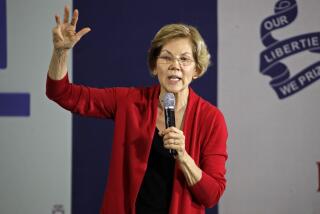Business Incentives Held Ineffective : Firms Use Tax Breaks but Don’t Expand, Study Claims
- Share via
WASHINGTON — Five years ago, President Reagan and Congress agreed on a bundle of business tax breaks designed to promote industrial expansion, but many major companies that reaped huge benefits from the 1981 changes actually cut back spending on new jobs and factories, a labor-backed tax reform group charged Monday.
Instead of pouring more money into new plants and equipment, many large companies spent the tax savings on stock dividends and corporate buy-outs, the group, Citizens for Tax Justice, concluded after a survey of 259 Fortune 500 firms.
“Pro-investment” tax breaks do not promote industrial expansion and in fact may discourage it, the study asserted.
“When presented with this unparalleled largess from the rest of the nation’s taxpayers . . . they took the money and spent it on virtually everything but new investment,” Robert S. McIntyre, the group’s director of federal tax policy, stated Monday.
A tax expert for the U.S. Chamber of Commerce later said that the study appeared to be based on inaccurate investment spending figures, a charge McIntyre denied.
The analysis, based on corporate annual reports and other public data, concluded that corporate income-tax incentives and other breaks cost the Treasury $120 billion in income tax revenue annually, triple the estimated value of all the corporate tax breaks on the books before the more generous rules were adopted in 1981.
But the breaks failed to trigger the investment and job booms promised when the tax changes were enacted, the report said. Among 44 profitable firms that used the tax breaks to avoid paying any federal income taxes from 1981 to 1984, for example, total investment spending was 4% lower in 1984 than in 1981 and overall employment was down 6%, the study found.
Communications giant ITT Corp., for instance, paid no federal income taxes and actually received refunds totaling $177.7 million from 1981 to 1984. But ITT’s reported investment spending was down 31% from 1981 to 1984, and employment declined 25%.
By comparison, the study states, capital investment was 21% greater in 1984 than in 1981 and employment was up 4% among 43 “highest-tax” firms that paid at least a third of their income in taxes.
Chamber of Commerce tax analyst David R. Burton charged that the study relies on investment data that distorts actual corporate spending. “By two different measures, investment has increased dramatically, not declined” as the study suggests, Burton said. Total spending by all U.S. companies on new factories and equipment rose by one-third between 1981 and 1985, he said, adding that some economists say 20% to 25% of that increase can be attributed to tax incentives enacted in 1981.
McIntyre said, however, that his group’s study relies on more specific spending data that focus on the precise investments that the 1981 tax incentives were designed to stimulate.
More to Read
Inside the business of entertainment
The Wide Shot brings you news, analysis and insights on everything from streaming wars to production — and what it all means for the future.
You may occasionally receive promotional content from the Los Angeles Times.










